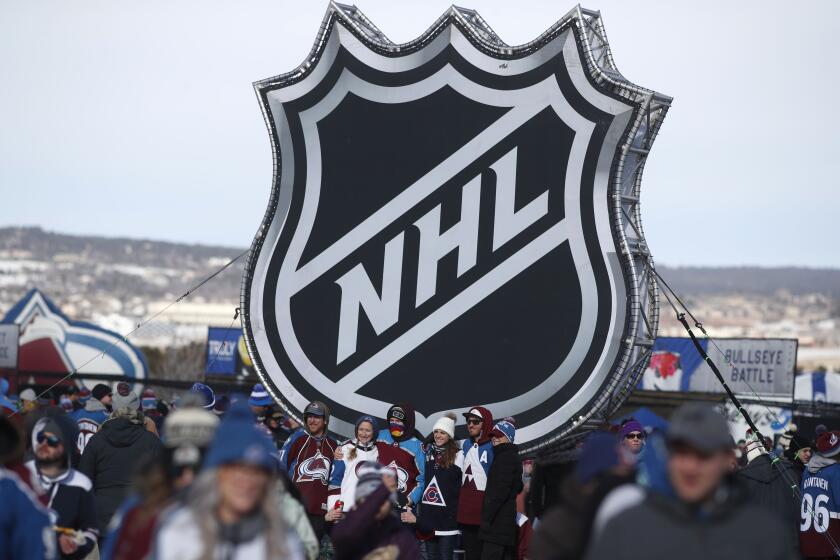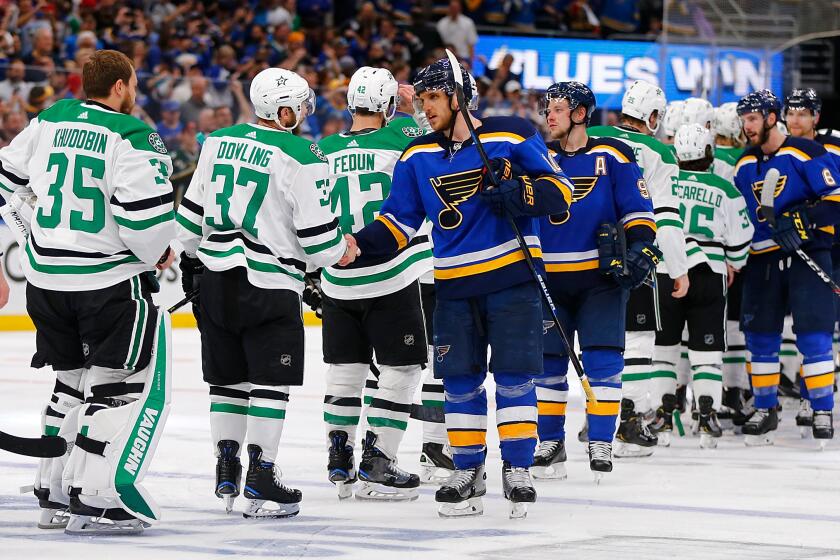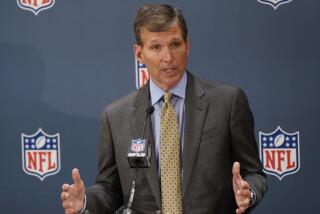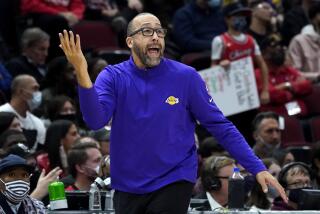NHL will allow players to train together as part of its next return phase

- Share via
The NHL and NHL Players’ Assn. issued a careful and sobering plan for the next phase of a return to play, vowing to put the health of players and club personnel first but acknowledging the joint directive regarding reopening clubs’ training facilities to small groups of players and requiring temperature checks, enhanced sanitary procedures and other measures “while very comprehensive, cannot mitigate all risk” of contracting COVID-19.
In a 22-page document released early Monday, the league and the union said the next phase in resuming operations will begin in early June and will be in effect for an undetermined amount of time. The NHL paused its season on March 12 due to the coronavirus outbreak. Last week, they agreed on the general outline of a 24-team playoff format and agreed to continue negotiating specific terms of the revised format for the Stanley Cup playoffs. Five members of the Ottawa Senators and three members of the Colorado Avalanche are known to have tested positive for COVID-19.
Under the terms of the Phased Return to Sport Protocol, a maximum of six players will be allowed in a club’s practice facility at one time in addition to a limited number of designated club personnel. Not all club personnel will be permitted to interact with players. Anyone who plans to visit a club training facility must undergo testing 48 hours in advance and receive a negative test result. All club personnel must participate in a remote educational meeting before Phase 2 begins, and all players will undergo a medical examination that checks for “any co-morbidities that may carry increased risk with COVID-19 infection” before participating in any activities.
The NHL Players’ Assn. on Friday approved the concept of the league’s proposal to resume play and complete the 2019-20 season. Talks will continue on key points.
Clubs were told to contact local health authorities to determine whether asymptomatic players and personnel are eligible for such tests, “provided that doing so does not take testing resources away from Publicly Necessary Testing.” If testing isn’t available, players and personnel would have to self-quarantine for 14 days before they could use training facilities, unless they can certify they had already served a 14-day quarantine.
Those who want to use club facilities must undergo temperature checks not more than two hours before they enter the facility and each club must administer a temperature check at the entrance to the facility. Club personnel who don’t have access to players also must undergo temperature checks before entering the building.
Those who develop symptoms of the novel coronavirus will be classified as unfit to play and won’t be permitted to practice or play. Clubs would have to carry out contact tracing. An isolated case wouldn’t lead to “widescale” quarantine of a club but anyone who came into contact with a player who tested positive is subject to testing.
Some players who traveled overseas to wait out the suspension of play might be required to spend 14 days in self-quarantine if local authorities have imposed that rule. “Even if not imposed by the local health authorities, such individuals returning to the Club’s home city by public transportation, including commercial air or rail travel must serve a 14-day self quarantine period post-travel before engaging in training activities at their club’s facility,” the memo said. “In addition, Club Medical personnel may impose a 14-day quarantine on Players and permitted Personnel returning to the Club’s home city from a high-risk environment, even if they are not traveling via public transportation.”
The memo — which was signed by NHL deputy commissioner Bill Daly, senior vice president and deputy general counsel Julie Grand and chief medical officer Dr. Willem Meeuwisse — said a list of high-risk environments will be given to clubs after the league and NHLPA consult. Teams are not permitted to require that players who are sheltering in place somewhere other than their team’s home city return in time to participate in Phase 2.
The coronavirus outbreak has athletes and medical experts from all over the world wondering how good sportsmanship can be embraced without shaking hands.
The protocol calls for voluntary non-contact skates with no coaches or skating coaches or other club employees participating. Players who participate in Phase 2 won’t be allowed to work out or skate at other locations. Physical distancing will be required in the locker room and weight room. In addition, the protocol said, “Players shall be encouraged to shower at home wherever possible,” and they must leave their workout clothes and anything they used during their workout at the facility.
At each session only one athletic trainer, one strength and conditioning coach, one equipment manager, up to two locker room attendants, one team physician and one goalie coach are permitted to be present. Players won’t be permitted to use hot and cold tubs, saunas, or steam rooms and they have been advised not to carpool or take public transportation to a club facility. Shared meals are banned but teams can provide prepackaged individual meals that players can take home with them. Massage therapists, agents, chiropractors, players’ family members and media are among those prohibited from entering club facilities during Phase 2. All personnel must wear face coverings except while exercising.
Updated cleaning and disinfecting procedures will be observed by each team before their facilities reopen and each team must appoint a Club Facility Hygiene Officer to oversee sanitizing procedures.
“As we have stated repeatedly, the health of the Players and Club personnel is our top priority,” the memo said. It also requested clubs respond to the memo with details about their ability to implement the newly required procedures and an estimated timing for each club to be in position to open its training facility.
More to Read
Go beyond the scoreboard
Get the latest on L.A.'s teams in the daily Sports Report newsletter.
You may occasionally receive promotional content from the Los Angeles Times.









